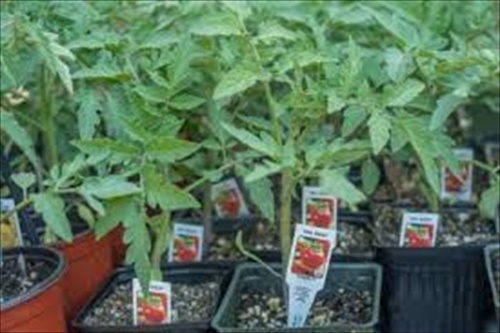8 Tips to Growing Better Tomatoes

A garden is just not a garden without the ramblings of tomato plants.
The warmer weather of our somewhat early spring took me into the garden to begin the reclamation of my much neglected suburban homestead. Between pulling weeds, mulching beds and turning over the soil I was eager to get some plants in the ground.
A few weeks before I had potted up a bunch of seeds in my greenhouse, but I wanted more instant gratification than those little seeds could provide. I wanted growing things! Badly.
The timing was perfect because the annual Tomatomania event was taking place at a local nursery that very weekend. It’s a celebration of sorts, all things tomato, for the serious tomato lover. The three day event touts over 300 different varieties of heirloom and hybrid tomato plants, from green to pink to orange to yellow, you can find anything you want, tomato wise. Some plants come in 4-inch pots and some in 1-gallon pots…for people who need more instant gratification than me I suppose.
To be honest, I’m not much of a fresh tomato person. Oh…I do enjoy sliced tomatoes and mozzarella with balsamic and basil, and a slice now and again on a burger, but that’s about it.
My favorite varieties are the fleshier roma or plum types rather than the juicy slicing varieties like Better Boy or Beefsteak.
After combing the racks I settled on 3 heirloom varieties – San Marzano, Orange Strawberry and Bleeding Heart.
The San Marzano is an indeterminate long-season red plum type variety with lots of thick flesh and a strong, sweeter and less acidic flavor that matures in about 90-days.
The Orange Strawberry is an indeterminate mid-season German variety, shaped like a strawberry with a deep orange color and a crisp sweet flavor that matures in about 80-days.
Bleeding Heart is an indeterminate mid-season multi-colored heart-shaped tomato with a mild sweet taste that matures in about 70-days.
My choices had more to do with color and interest than production or canning ability. I wanted something new, something I had never grown before for my new garden. But, that doesn’t mean I don’t want them to produce well.
So—what do all these terms mean? Read on!
Tomato Terms
Determinate tomato plants reach a certain height and produce most of their fruits in a short period of time, which makes them perfect for homesteads that want to can sauces or paste. Determinate types also make great choices for container or patio growing.
Indeterminate tomato plants continue to set fruit all along its stems throughout their growing season. These are also more rambling plants that need extra support to keep the fruit off the ground.
Early Variety are tomatoes that ripen fruit in 50 to 60 days. These are prized for bringing fruit off long before most other varieties, or being planted in the late summer for an early fall crop.
Mid-season varieties are those that can be harvested in the middle of the growing season, typically ripening fruit in 70 to 80 days.
Late-season varieties are those that take 90 or more days to ripen fruit. These are traditionally varieties that won’t be picked until late summer.
Most suburban homesteaders like the mid-season varieties with a goal (or challenge) of getting tomatoes by July 4th.
Tips for Growing Better Tomatoes
1.) Make Your Choice. Choose a variety that is best for you and your area. Choose early, mid- or late-season tomatoes, letting the “days to maturity” guide you. Choose seedlings with sturdy stems and bright green foliage.
2.) Find a sunny spot. Tomatoes love sun and heat. 6 hours is the minimum and 8 hours is preferable. If your area is unusually hot during the day you may need to rig up some shade during the hottest part.
3.) Amend the soil. Be generous with soil amendments and compost and remember to feed your plants with organic fertilizer. Tomatoes love a good rich soil. Layering over the top of the soil will protect the roots from being disturbed by tilling.
4.) Plant seedlings deep. Remove the lower sets of leaves and plant up to the remaining leaves, leaving about 3 to 4-inches of plant above the surface. The little leaf nodes will send out roots, making you plants sturdy and better able to carry the weight of the crop.
5.) Be water wise. Watering correctly means soaking the root ball every 3 to 4 days for the first few weeks after planting. Proper watering can affect the taste as the tomatoes grow, so once the plant starts growing, water deeply and less frequently, giving them just what they need.
6.) Fertilize. Feed plants around the root zone once they are established and again when they flower. If your soil is depleted you may need to fertilize more often or with a particular fertilizer to address the deficiency.
7.) Provide support! Especially with indeterminate varieties, since some of these can get to be 10-feet tall. Stakes or bamboo are good and sturdy. Cages also work well.
8.) Be patient! Just because a tomato is red (or yellow or pink or orange) doesn’t mean it is at its peak of flavor. Look for a deep true color of the variety and some give when touched before devouring your harvest.
These steps will help you get the most out of your tomato season!

Recent comments
Aenean nonummy hendrerit mauris. Phasellus porta.